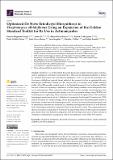Por favor, use este identificador para citar o enlazar a este item:
http://hdl.handle.net/10261/310536COMPARTIR / EXPORTAR:
 SHARE SHARE
 CORE
BASE CORE
BASE
|
|
| Visualizar otros formatos: MARC | Dublin Core | RDF | ORE | MODS | METS | DIDL | DATACITE | |

| Título: | Optimized De Novo Eriodictyol Biosynthesis in Streptomyces albidoflavus Using an Expansion of the Golden Standard Toolkit for Its Use in Actinomycetes |
Autor: | Magadán-Corpas, Patricia CSIC ORCID; Ye, Suhui; Pérez-Valero, Álvaro; McAlpine, Patrick L.; Valdés-Chiara, Paula; Torres-Bacete, Jesús CSIC ORCID; Nogales, Juan CSIC ORCID ; Villar, Claudio J.; Lombó, Felipe | Palabras clave: | Eriodictyol Naringenin Flavonoid Streptomyces Synthetic biology Golden Standard CRISPR-Cas9 SEVA Chimaera |
Fecha de publicación: | 17-may-2023 | Editor: | Multidisciplinary Digital Publishing Institute | Citación: | International Journal of Molecular Sciences 24(10): 8879 (2023) | Resumen: | Eriodictyol is a hydroxylated flavonoid displaying multiple pharmaceutical activities, such as antitumoral, antiviral or neuroprotective. However, its industrial production is limited to extraction from plants due to its inherent limitations. Here, we present the generation of a Streptomyces albidoflavus bacterial factory edited at the genome level for an optimized de novo heterologous production of eriodictyol. For this purpose, an expansion of the Golden Standard toolkit (a Type IIS assembly method based on the Standard European Vector Architecture (SEVA)) has been created, encompassing a collection of synthetic biology modular vectors (adapted for their use in actinomycetes). These vectors have been designed for the assembly of transcriptional units and gene circuits in a plug-and-play manner, as well as for genome editing using CRISPR-Cas9-mediated genetic engineering. These vectors have been used for the optimization of the eriodictyol heterologous production levels in S. albidoflavus by enhancing the flavonoid-3′-hydroxylase (F3’H) activity (by means of a chimera design) and by replacing three native biosynthetic gene clusters in the bacterial chromosome with the plant genes matBC (involved in extracellular malonate uptake and its intracellular activation into malonyl-CoA), therefore allowing more malonyl-CoA to be devoted to the heterologous production of plant flavonoids in this bacterial factory. These experiments have allowed an increase in production of 1.8 times in the edited strain (where the three native biosynthetic gene clusters have been deleted) in comparison with the wild-type strain and a 13 times increase in eriodictyol overproduction in comparison with the non-chimaera version of the F3′H enzyme. | Versión del editor: | https://doi.org/10.3390/ijms24108879 | URI: | http://hdl.handle.net/10261/310536 | DOI: | 10.3390/ijms24108879 | ISSN: | 1661-6596 | E-ISSN: | 1422-0067 |
| Aparece en las colecciones: | (CNB) Artículos |
Ficheros en este ítem:
| Fichero | Descripción | Tamaño | Formato | |
|---|---|---|---|---|
| Optimized_Magadan.pdf | 2,53 MB | Adobe PDF |  Visualizar/Abrir |
CORE Recommender
SCOPUSTM
Citations
7
checked on 05-may-2024
WEB OF SCIENCETM
Citations
3
checked on 26-feb-2024
Page view(s)
38
checked on 12-may-2024
Download(s)
60
checked on 12-may-2024
Google ScholarTM
Check
Altmetric
Altmetric
Este item está licenciado bajo una Licencia Creative Commons

